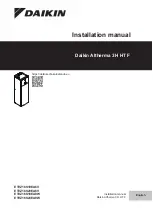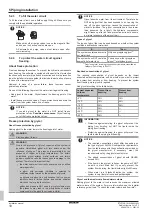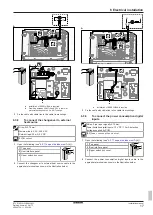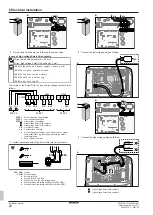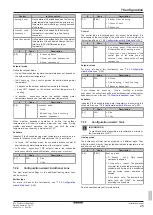
5 Piping installation
Installation manual
10
ET9W
Daikin Altherma 3 H HT F
4P644730-1 – 2021.02
5.2.3
To fill the water circuit
To fill the water circuit, use a field supply filling kit. Make sure you
comply with the applicable legislation.
NOTICE
Make sure both air purge valves (one on the magnetic filter
and one on the backup heater) are open.
All automatic air purge valves must remain open after
commissioning.
5.2.4
To protect the water circuit against
freezing
About freeze protection
Frost can damage the system. To prevent the hydraulic components
from freezing, the software is equipped with special frost protection
functions such as water pipe freeze prevention and drain prevention
(see the installer reference guide) that include the activation of pump
in case of low temperatures.
However, in case of a power failure, these functions cannot
guarantee protection.
Do one of the following to protect the water circuit against freezing:
▪ Add glycol to the water. Glycol lowers the freezing point of the
water.
▪ Install freeze protection valves. Freeze protection valves drain the
water from the system before it can freeze.
NOTICE
If you add glycol to the water, do NOT install freeze
protection valves.
Possible consequence:
Glycol leaking
out of the freeze protection valves.
Freeze protection by glycol
About freeze protection by glycol
Adding glycol to the water lowers the freezing point of water.
WARNING
Ethylene glycol is toxic.
WARNING
Due to the presence of glycol, corrosion of the system is
possible. Uninhibited glycol will turn acidic under the
influence of oxygen. This process is accelerated by the
presence of copper and high temperatures. The acidic
uninhibited glycol attacks metal surfaces and forms
galvanic corrosion cells that cause severe damage to the
system. Therefore it is important that:
▪ the water treatment is correctly executed by a qualified
water specialist,
▪ a glycol with corrosion inhibitors is selected to
counteract acids formed by the oxidation of glycols,
▪ no automotive glycol is used because their corrosion
inhibitors have a limited lifetime and contain silicates
which can foul or plug the system,
▪ galvanized pipes are NOT used in glycol systems since
the presence may lead to the precipitation of certain
components in the glycol's corrosion inhibitor.
NOTICE
Glycol absorbs water from its environment. Therefore do
NOT add glycol that has been exposed to air. Leaving the
cap off the glycol container causes the concentration of
water to increase. The glycol concentration is then lower
than assumed. As a result, the hydraulic components
might freeze up after all. Take preventive actions to ensure
a minimal exposure of the glycol to air.
Types of glycol
The types of glycol that can be used depend on whether the system
contains a domestic hot water tank:
If…
Then…
The system contains a domestic
hot water tank
Only use propylene glycol
(a)
The system does NOT contain a
domestic hot water tank
You can use either propylene
glycol
(a)
or ethylene glycol
(a)
Propylene glycol, including the necessary inhibitors, classified as
Category III according to EN1717.
Required concentration of glycol
The required concentration of glycol depends on the lowest
expected outdoor temperature, and on whether you want to protect
the system from bursting or from freezing. To prevent the system
from freezing, more glycol is required.
Add glycol according to the table below.
Lowest expected
outdoor
temperature
Prevent from
bursting
Prevent from
freezing
–5°C
10%
15%
–10°C
15%
25%
–15°C
20%
35%
–20°C
25%
—
–25°C
30%
—
–30°C
35%
—
INFORMATION
▪ Protection against bursting: the glycol will prevent the
piping from bursting, but NOT the liquid inside the
piping from freezing.
▪ Protection against freezing: the glycol will prevent the
liquid inside the piping from freezing.
NOTICE
▪ The required concentration might differ depending on
the type of glycol. ALWAYS compare the requirements
from the table above with the specifications provided by
the glycol manufacturer. If necessary, meet the
requirements set by the glycol manufacturer.
▪ The added concentration of glycol should NEVER
exceed 35%.
▪ If the liquid in the system is frozen, the pump will NOT
be able to start. Mind that if you only prevent the
system from bursting, the liquid inside might still freeze.
▪ When water is at standstill inside the system, the
system is very likely to freeze and get damaged.
Glycol and the maximum allowed water volume
Adding glycol to the water circuit reduces the maximum allowed
water volume of the system. For more information, see the installer
reference guide (topic "To check the water volume and flow rate").
Содержание ETVZ16S23EA9W
Страница 38: ......
Страница 39: ......
Страница 40: ...4P644730 1 2021 02 Copyright 2021 Daikin 4P644730 1 0000000M Verantwortung f r Energie und Umwelt...

